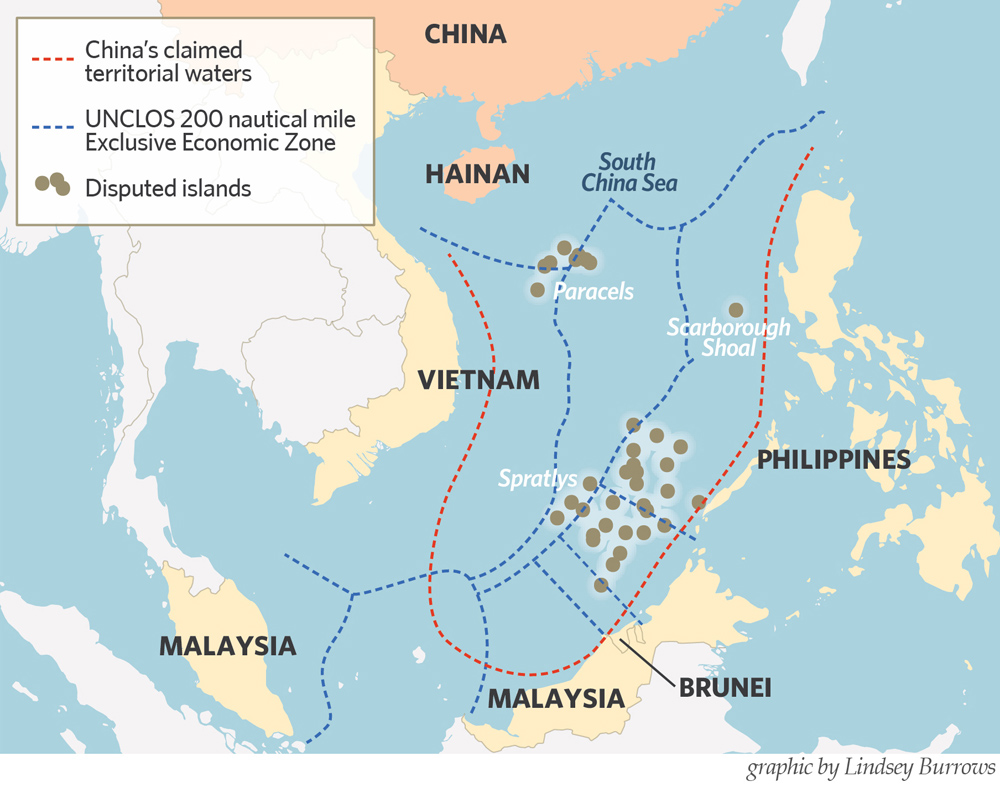Many opposite and adjacent coastal States assert overlapping claims to territorial sea. Such areas are subject to LOSC Article 15, which provides as follows:
Delimitation of the territorial sea between States with opposite or adjacent coasts
Where the coasts of two States are opposite or adjacent to each other, neither of the two States is entitled, failing agreement between them to the contrary, to extend its territorial sea beyond the median line every point of which is equidistant from the nearest points on the baselines from which the breadth of the territorial seas of each of the two States is measured. The above provision does not apply, however, where it is necessary by reason of historic title or other special circumstances to delimit the territorial seas of the two States in a way which is at variance therewith.
This provision in a near-verbatim reproduction of the equivalent provision of the 1958 Territorial Sea Convention. It reflects a compromise reached at UNCLOS I – and again at UNCLOS III – between two general proposed methods of delimitation.
The first proposed method emphasized application of an equidistance/median line; while the second emphasized application of equitable principles taking into account range of relevant circumstances. The compromise language does not prescribe a particular method of delimitation.
LOSC Article 15 also stipulates that territorial sea boundaries are to be delimited by agreement between the coastal States advancing overlapping claims. This is consistent with the long-standing position of customary international law that a unilateral determination of a maritime boundary by a coastal State is not binding upon other coastal States.
LOSC Article 15 does not establish detailed substantive or procedural obligations concerning the provisional management of a territorial sea OCA. Proposals by several States to include such obligations were not incorporated into the final text of the Convention. However, the first sentence of LOSC Article 15 does not prohibit a coastal State from extending its territorial sea on a unilateral basis within an OCA, provided that the zone is not extended beyond the relevant equidistance line between opposite or adjacent coasts. Accordingly, it notionally facilitates provisional management of a territorial sea OCA on a unilateral basis and prevents unilateral management measures from overlapping spatially. In such circumstances, an equidistance line would act as a provisional de facto territorial sea boundary.
The second sentence of LOSC Article 15 excludes the application of the first sentence (concerning extension of the territorial sea within an OCA) where the presence of historic title or ‘other special circumstances’ renders it ‘necessary’ to designate a boundary that departs from the equidistance line. This exclusion dramatically curtails the ability of a coastal State to rely on Article 15 as a basis for undertaking unilateral management measures within a territorial sea OCA, for the following reasons:
First, the exclusion is framed in broad terms and the LOSC does not elaborate upon the range of ‘special circumstances’ necessitating the departure of a boundary from an equidistance line. During UNCLOS III several States proposed the inclusion of additional procedural and substantive rules that would apply in the context of historic title or other special circumstances. However, these proposals were not incorporated into the final text of the Convention. Nonetheless, international courts and tribunals – in particular the International Court of Justice – have developed an increasingly clear and consistent approach to determining when a boundary should depart from an equidistance line. The approaches used by these bodies to delimit the territorial sea, continental shelf and EEZ are also increasingly convergent. In recent cases international courts and tribunals have first determined a presumptive equidistance line and then proceeded to enquire whether relevant or special circumstances warrant a change in that line in order to achieve an ‘equitable result.’
Relevant or special circumstances identified and applied by international courts and tribunals are diverse, and may have countervailing effects on the course of a maritime boundary. They include the configuration and length of relevant respective coastlines, the existence of islands, security considerations and the prior conduct of parties.
Second, LOSC Article 15 conceptually links obligations concerning unilateral provisional management with obligations concerning boundary delimitation. The factors that determine the course of the delimitation line also determine the entitlement of a State to undertake unilateral management measures on a provisional basis. As a result, disagreement between coastal States concerning the location of a territorial sea boundary automatically entails disagreement concerning the entitlement to undertake unilateral provisional management measures.

